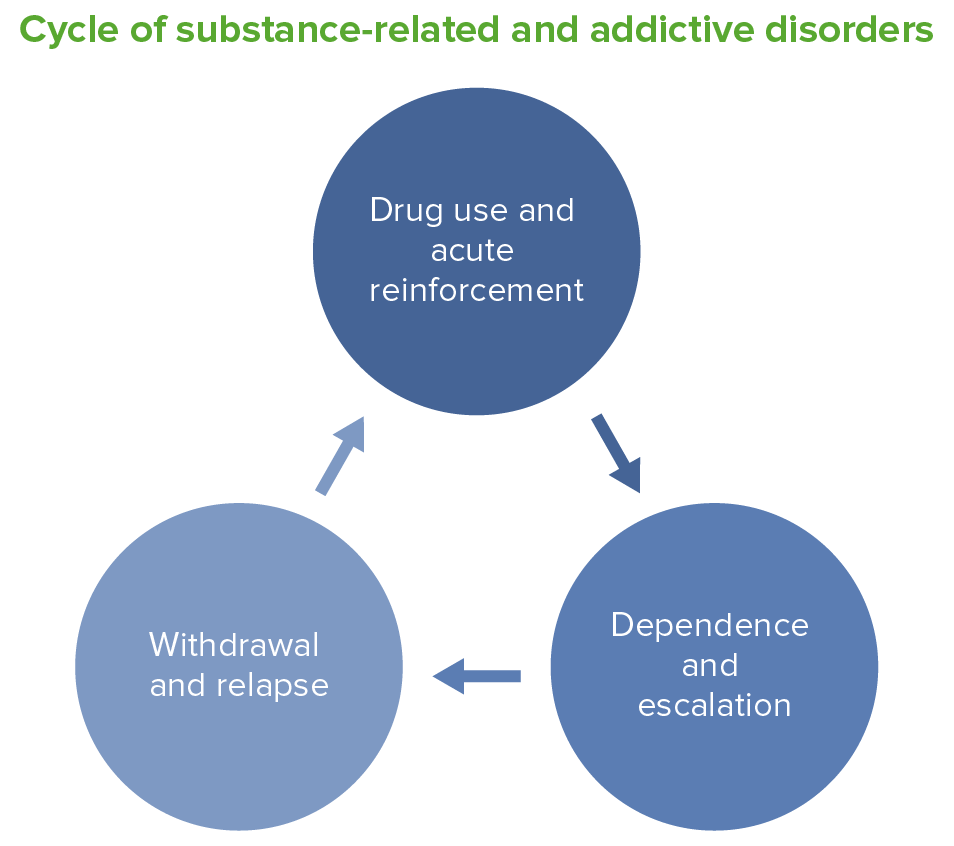Playlist
Show Playlist
Hide Playlist
Sedative/Hypnotic Drugs: Benzodiazepines, Barbiturates and Ethanol – Drugs of Abuse
-
Slide Sedative Hypnotic Drugs Drugs of Abuse.pdf
-
Reference List Pharmacology.pdf
-
Download Lecture Overview
00:01 Hi, welcome to the pharmacology course by Lecturio. This lecture and this course is about toxicology and we're going to cover some of the drugs of abuse that are common in our culture. 00:13 The first group of drugs that we'll talk about are the sedative hypnotics. 00:17 This includes the benzodiazepine, the barbiturates and the ethanol. 00:22 With respect to benzodiazepines, they often end in -lam or -pam. 00:27 So, rohypnol is probably the most commonly abused of these drugs. It is no longer used in clinical practice. 00:36 It is often referred to as the date rape drug. It's also called a "roofie". 00:41 This is in contrast to GHB, which are also called "roofies", but they are called "roofies" incorrectly because they are different from rohypnol. 00:49 GHB is not a benzodiazepine, but does act as an agonist to GABA-B receptors. 00:54 Additionally, it is a precursor molecule of GABA. It is often used as a club drug. 00:59 You get euphoria, enhanced sensory perception and amnesia and it is also sometimes used in date rape. 01:06 The other benzodiazepines are more clinically used and I've listed them here so that you can have them for reference. 01:13 In terms of how they affect the human body, they are used predominantly for anti-anxiety, and they can be used as an adjunct for depression as well. 01:23 They may follow the dopaminergic method of addiction. 01:26 And benzos are often used with alcohol in the "date rape" phenomenon. 01:30 Depressant effects are potentiated by marijuana, opioids and antipsychotics. 01:36 And in terms of the symptoms of intoxication they are similar to ethanol with sedation and respiratory depression. 01:42 Some benzodiazepines can cause a rapid pulse and dilated pupils. 01:46 The antidote to all benzos is flumazenil. And it's often kept in code cards and it's often kept in addiction centers. 01:55 Withdrawal treatment is usually switching them to a longer acting benzodiazepine, and this gives them reduced seizure activity and it gives us an ability to gradually reduce the dose with a minimum side effects. 02:09 Diazepam is probably one of the most commonly used long acting agent to get people off of these short acting benzos. 02:18 Sometimes we may need to add a barbiturate, such as phenobarbital, for severe or refractory withdrawal symptoms. 02:24 Withdrawal symptoms include anxiety, tremor, tachycardia and hypertension, and we have a particular concern for seizures. 02:32 Barbiturates are generally thought of as more potent and more dangerous than benzodiazepines. 02:38 The short acting barbiturates like secobarbital are very very addictive. 02:43 In medical practice, it's replaced by benzodiazepines in terms of treating anxiety, but we still sometimes use barbiturates in anticonvulsant therapy. 02:53 And it's often used in euthanasia and in illegal interrogation. 02:57 Now, what's concerning about secobarbital is that it is very commonly abused by physicians and nurses. 03:03 So, if you start to see this kind of behaviour in a healthcare practitioner, start thinking about secobarbital. 03:11 Withdrawal treatment. Use a long acting barbiturate or benzodiazepine to reduce seizure activity and give a gradual reduction of dose. 03:19 So, the treatment is going to be exactly the same as benzo overdoses. 03:23 So, diazepam, also called valium, is a long benzo and I mentioned that to you before. 03:29 Now, one of the things that we have to be very aware of and we've talked about this in our pharmacology pharmacokinetics course is that it may induce CYP2C9. So, co-administration with codeine can actually have lethal effects of the codeine when patients also take barbiturates.
About the Lecture
The lecture Sedative/Hypnotic Drugs: Benzodiazepines, Barbiturates and Ethanol – Drugs of Abuse by Pravin Shukle, MD is from the course Toxicology. It contains the following chapters:
- Benzodiazepines
- Barbiturates
Included Quiz Questions
What is an antidote to benzodiazepines?
- Flumazenil
- Fomepizole
- Naloxone
- Epinephrine injection
- Hemodialysis
What is the most appropriate medication for the treatment of benzodiazepine withdrawal?
- Diazepam
- Metoprolol
- Flumazenil
- Fomepizole
- Naloxone
Which best describes diazepam?
- It is a long-acting benzodiazepine.
- It is a short-acting barbiturate, known to be very addictive.
- It is an opioid.
- It is a medium-acting benzodiazepine, which bypasses the liver during metabolism.
- It is a street drug often used in date rape.
Customer reviews
5,0 of 5 stars
| 5 Stars |
|
5 |
| 4 Stars |
|
0 |
| 3 Stars |
|
0 |
| 2 Stars |
|
0 |
| 1 Star |
|
0 |






